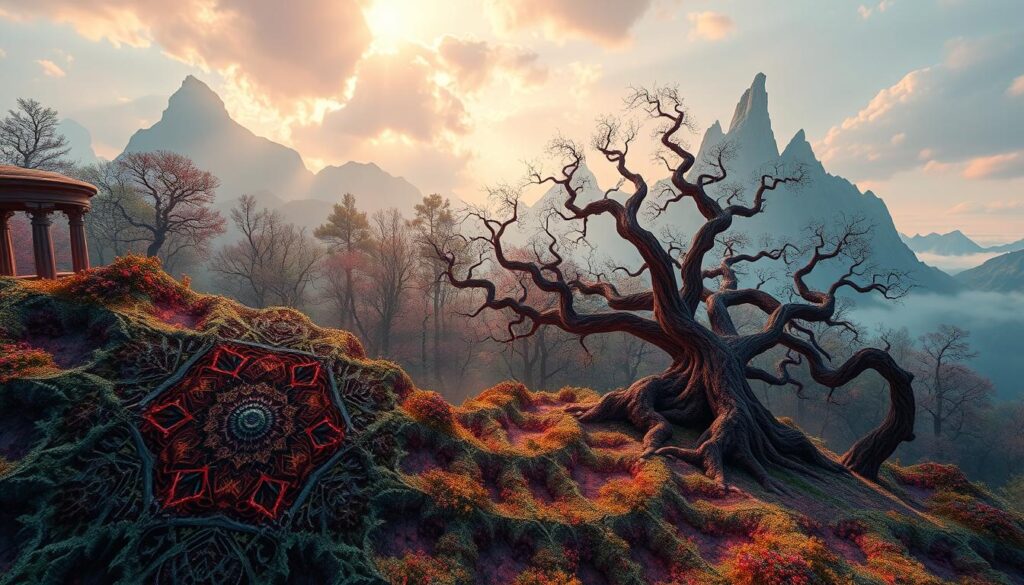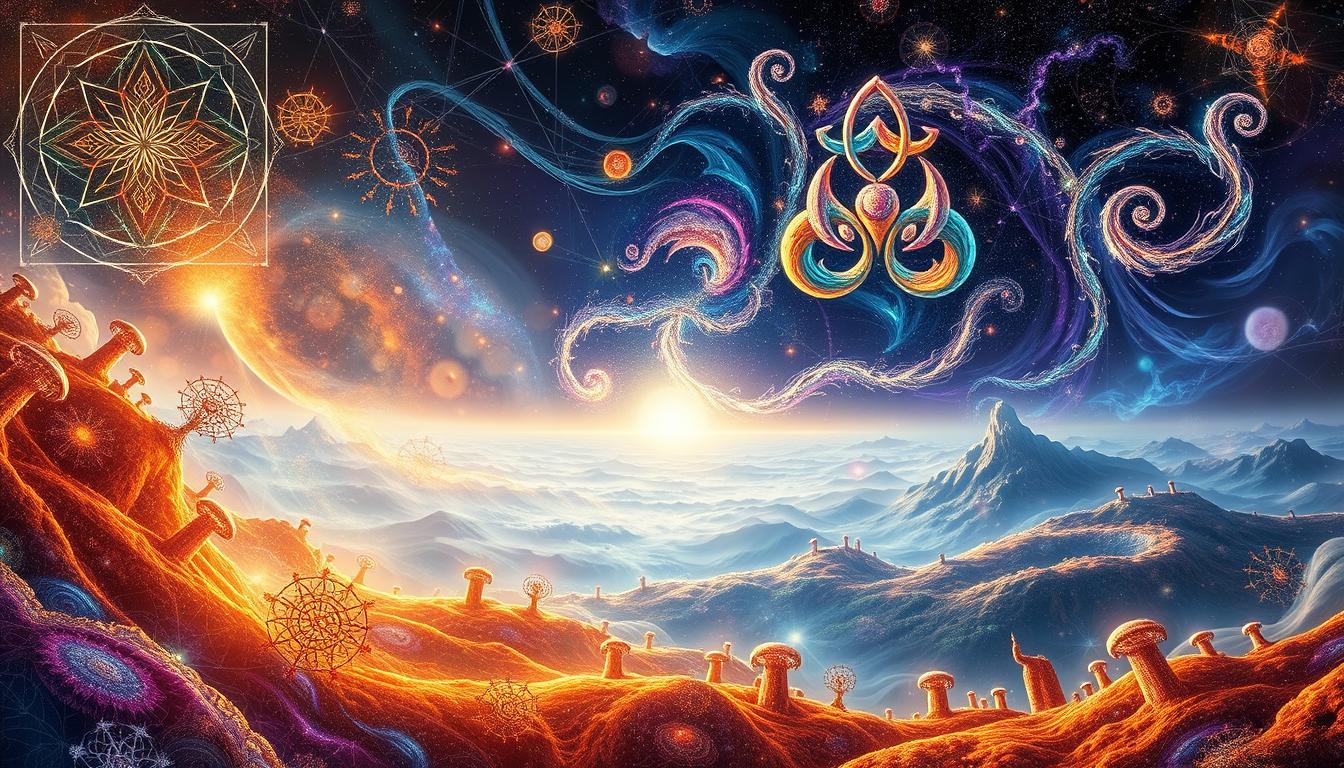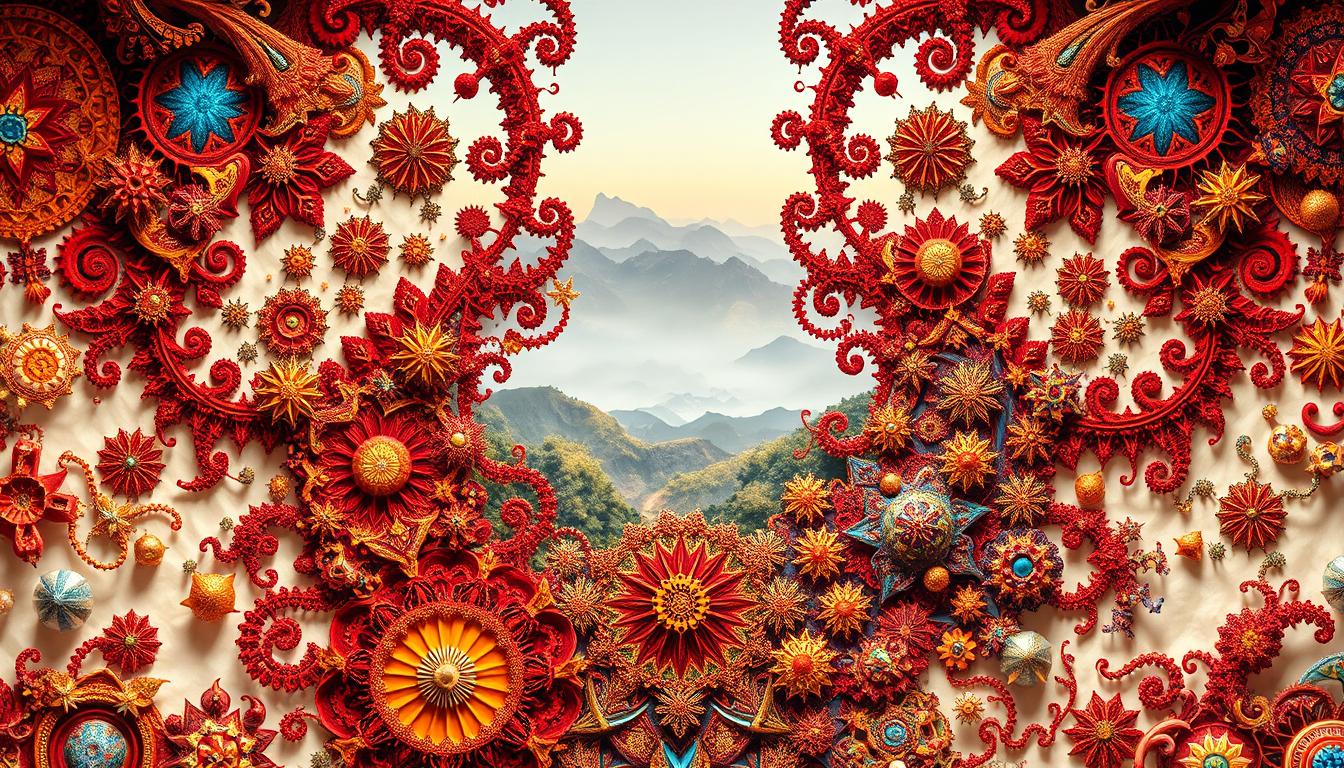Fractal beauty in stories shows complex patterns from simple beginnings. Like nature’s patterns, fractal storytelling layers tales to deepen their meanings. It helps us see how old tales gain new meanings over time.
This study links chaos and order, showing how stories reflect the natural world’s beauty.
Understanding Fractal Beauty in Traditional Storytelling
Fractal beauty in traditional storytelling is like a mix of being complex and simple at the same time. This mix makes stories as captivating as beautiful natural patterns. The way these stories are put together can really speak to our hearts, thanks to their symmetry and balance.
When we dive into stories, looking for fractal patterns brings out rich meanings. It makes the stories more touching and profound. Things like repeating themes or the growth of characters add depth. They make the story feel whole.
By looking into these complex patterns, storytellers can craft tales that really draw us in. They encourage us to see deeper meanings in the storylines.

The Connection Between Fractals and Narrative Structure
Fractals are not just math concepts; they shape stories too. Stories use fractals in patterns and themes that repeat. These patterns show how characters move, face conflicts, and find solutions in stories.
Storytelling uses recursion, similar to fractals, with connected story arcs. Characters meet challenges that are kind of the same but at different times. This makes stories more complex and emotionally touching.
Knowing how fractals work with stories helps creators make better stories. This knowledge lets them build deeper stories that mean more to the audience. Writers use this to make characters and themes more complex, making stories memorable and powerful.
Examples of Fractal Patterns in Popular Folktales
Fractal patterns are common in folktales, showing how repeated themes and motifs make stories richer. These tales capture important human experiences. They let audiences deeply engage with elements that reflect bigger truths. By looking at folktale motifs, we see how stories connect across generations.
Repetitive Themes and Motifs
Many folktales share the theme of good fighting evil, appearing at different story levels. Here are typical folktale motifs that have a fractal quality:
- Transformation and redemption stories about personal growth.
- Heroic journeys highlighting bravery and sacrifice.
- Justice for villains, teaching moral lessons.
These stories often strike a chord with people, reminding them of worldwide issues and virtue’s victory over wickedness.
Microcosms Reflecting Macrocosms
Folktales can act like small windows into greater cultural values. They show us social norms, moral teachings, and historical contexts. Some key aspects are:
- How community and family are portrayed in the story.
- Nature lessons symbolizing bigger ecological and life themes.
- Character types that show cultural roles and values.
These factors make the narrative stronger. They help folktales entertain but also carry cultural stories, passing down wisdom.
The Role of Nature in Creating Fractal Narratives
Nature is a deep well of inspiration for storytelling. It shapes both story lines and character growth. The complex patterns in ecosystems mirror life’s complexities in stories. Writers use nature’s beauty to enrich their narratives.
Nature’s elements add life to both characters and settings. Stories often reflect nature’s cycles, creating a connection with readers. For example, changing seasons can show a character’s personal growth. This brings a poetic touch to the storytelling.
The bond between storytelling and nature highlights the role of environmental themes in writing. Authors use landscapes or natural cycles to create layered experiences. This combination of narrative and environment makes stories deeply engaging for readers.
Analyzing Character Development Through Fractal Lenses
Looking at character development through fractal dynamics shows amazing patterns in their stories. Like fractals, character arcs have similar patterns at different scales. These patterns add depth to the characters and mirror the story’s main themes. This method shows how characters are connected, shedding light on their joint adventures.
Complexity of Character Arcs
Character arcs are like a rich, evolving story. Through the lens of fractal dynamics, we see that these arcs follow fractal patterns. They have ups and downs, showing what characters feel.
Looking at these patterns helps us understand the story’s themes and emotions.
Interconnected Relationships Among Characters
Stories show complex relationships between characters. Their connections form a web, showing how they affect each other. They grow and face challenges together.
By studying these interactions, we learn more about the story. It reveals how character arcs intertwine and influence the story’s direction.
Fractal Beauty in Mythology and Legends
Myths often show fractal beauty, with themes and symbols repeating. Different cultures’ legends share patterns that appeal to many. They use recurring motifs to reflect shared experiences, containing universal truths in their tales.
Legendary stories often feature archetypal characters that repeat over time. This repetition adds depth, helping people learn important morals. For example, the hero’s journey, seen in many myths, shows growth through challenges and wins.
Studying these stories, we see how themes create complex reflections of culture. The link between one story and the broader culture highlights legends’ fractal nature. It shows their impact on our collective identity and heritage.
Exploring Fractal Beauty in Traditional Storytelling
Fractal beauty brings depth to traditional stories. It shows the complex layers found in storytelling. Each layer adds a deeper meaning, connecting with audiences emotionally and intellectually. These stories share complex themes using repeating patterns and linked elements. Storytellers use these patterns to create engaging worlds. In these worlds, stories reflect each other through rhythm and theme.
Different cultures show this idea through their storytelling traditions. For example, indigenous tribes use fractal patterns in their oral stories. They do this to keep history alive, teach lessons, and share myths. This type of storytelling captures the audience. It also helps them understand cultural values better. Feeling connected to these stories shows why it’s important to see fractal beauty in traditional storytelling.
Conclusion
As we delve into the beauty of fractals in traditional stories, it’s clear they offer deep storytelling insights. These patterns across cultures show that stories are more than straight lines. They mirror the complexity we see in nature. By looking into fractal elements in stories, we understand human connections better.
Fractal beauty adds to both the look and meaning of stories, letting us connect with them more deeply. This approach helps us see meanings that aren’t immediately obvious. The way characters, motifs, and themes weave together shows life’s complex patterns, capturing our imaginations.
Recognizing fractal structures in stories is key to understanding human nature better. Diving into these narratives lets us see their beauty and connects us deeply to our world. We become part of a shared human storytelling tradition.



